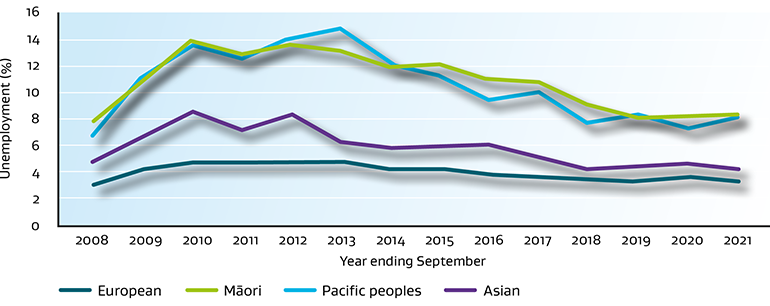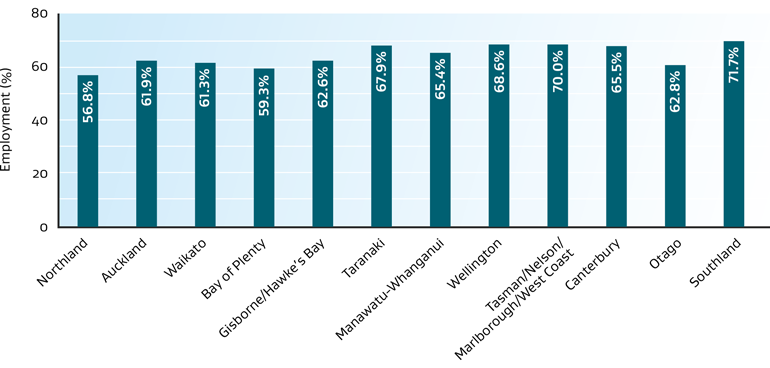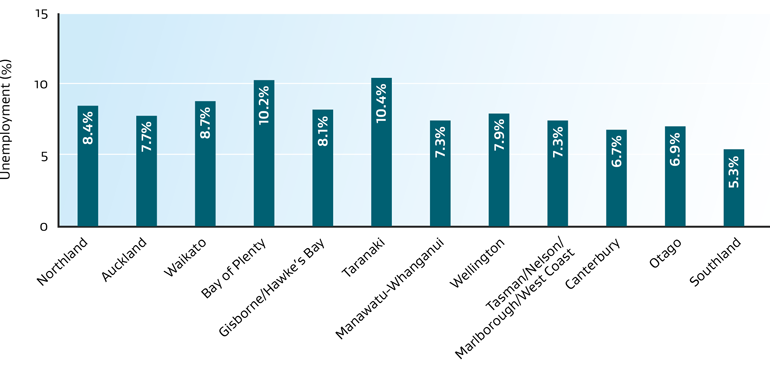Why we need this Action Plan
Employment makes an important contribution to wellbeing.
On this page
Being employed in quality work makes an important contribution to waiora (wellbeing) and socioeconomic outcomes. Work can improve an individual’s waiora, and also support the wellbeing of their whānau and community, and that of future generations.
Work can contribute to:
- financial security, by supporting people to achieve sustainable, intergenerational prosperity (mana whanake)
- health, as quality and stable work are key factors in good health (hauora), especially mental health
- purpose, when people can realise their aspirations in the context of their own unique circumstances (mana āheinga)
- social interaction and social cohesion, as it enables people to contribute to their community, learn new skills and make social connections; and provides them with a sense of identity and belonging (mana tuku iho).
Not all employment provides these benefits. The Government wants to ensure Māori have the option to engage in quality work, or mahi tūturu. ‘Tūturu’ can mean permanent, real, actual, authentic or legitimate. When prefixed with ‘mahi’, it means legitimate, permanent, full-time and part-time mahi.
Positive trends for Māori
Over the last decade, there has been much progress in Māori succeeding as Māori. While this Action Plan intentionally focuses on the strengths and potential of Māori, in keeping with Te Tiriti principle of equity, the Government must be aware of any inequities in the EET system so it can confront and address them.
Māori experiencing poor labour market outcomes reflects the EET system not providing adequate support for ākonga Māori, kaimahi Māori and Māori businesses. Māori face barriers and negative experiences due to policies and practices that do not take Māori experiences into account. Achieving meaningful and sustainable change requires addressing multiple intersecting problems within the government, regulatory systems, in workplaces and wider society. The Action Plan is one tool to achieve this change.
Māori and education
The education system underperforms for Māori, but there have been positive shifts towards equitable performance and participation. Improving outcomes for ākonga Māori, across the education system, lays the foundation for transitioning into work. The same applies to giving ākonga Māori clear pathways to follow, from school to post-school training or employment. Supporting kaimahi Māori to continue developing skills at work, throughout their careers, increases productivity and income. Having the right education, training and support are key factors to finding and retaining quality employment.
The education system has underperformed for ākonga Māori and their whānau. As a result, ākonga Māori experience worse educational outcomes than other New Zealand learners. Negative education outcomes have a direct impact on participation in the labour market and employment outcomes. This has significant social, cultural, health and economic impacts on individuals, and on iwi, hapū and whānau, spanning generations.
Lots of anecdotal evidence exists on racial bias towards Māori in education. In a report by the Office of the Children’s Commissioner, tamariki Māori talked about racism and unequal treatment by other children and educators. Many tamariki Māori spoke of the need to develop relationships of trust with their teachers. However, research confirms that teacher bias and low expectations exist across the teaching workforce, which can prevent or delay the learning and development of tamariki.
He manu kai mātauranga: He tirohanga Māori [PDF 1.3MB](external link) — Office of the Children's Commissioner
Unconscious bias and education: A comparative study of Māori and African American students [PDF 1MB](external link) — Oranui Diversity Leadership
There have been positive shifts towards equitable performance and participation. One of those shifts is growing and sustaining the Māori-medium sector. (Māori-medium education (MME) refers to education settings which deliver the curriculum in, and through, te reo Māori for at least 51% of the time (immersion levels 1 and 2).) Māori enrolled in Māori-medium education achieve better educational outcomes. For example, compared with Māori in English-medium education, ākonga in Māori-medium education (MME) are 15 to 20% more likely to attain NCEA Level 2. They have the highest level of attainment of NCEA Level 3 of any cohort; this is higher than total school leavers and significantly higher than Māori enrolled in English-medium education. Retention rates of ākonga Māori are also higher in MME than they are in English-medium schools. Since 2008, Māori learners’ achievement of national standards in reading, writing and maths has also been slowly increasing.
By growing MME, we can produce sufficient te reo Māori speakers to revitalise the language. Research shows increasing demand from employers for te reo Māori speakers, which shows a current, and potential future, demand for this skill.
The number of Māori students gaining post-secondary-school qualifications is also increasing. Individuals who gain a post-secondary-school qualification are more likely to be employed and earn higher incomes. In 2018, 30% of Māori were enrolled in full-time study, compared with 21% of the general population.
In 2018, 21% of Māori aged 15 and older had a Level 5 diploma or higher, which is 16% higher than in 2013. In 2019, Māori made up 22% of all domestic university students, which is 2% higher than in 2010. In 2018, 23% of Māori students in tertiary education were studying at postgraduate level, up from 20% in 2010. The number of Māori doctorate students has increased by 24% since 2010. Furthermore, 5 years after they finish studying, Māori doctoral graduates earn more than non-Māori graduates
Almost half (48%) of recent Māori university graduates are the first people in their families to attend university. One third of the graduates are parents, and 70% are wāhine Māori. This is another positive shift that will have an impact on future generations and their access to improved employment options.
Māori-medium Education(external link) — Education Counts website
Māori and employment
Māori are concentrated in employment that is often precarious and more susceptible to disruption.
Type of employment relationship by ethnicity (September 2021 quarter)
| Ethnicity | Temporary employees | Permanent employees | Employees (temporary and permanent) | Employers | Self-employed |
|---|---|---|---|---|---|
| Māori | 10% | 91% | 86% | 3% | 10% |
| All ethnic groups | 9% | 89% | 80% | 6% | 12% |
Source: Stats NZ data
The proportions of Māori and all ethnic groups in full-time and part-time work is similar with 79% of Māori in full-time employment (compared with 80% for all ethnic groups) and 21% in part-time employment (20% for all ethnic groups).
Household labour force survey(external link) — Stats NZ website
Research by Te Puni Kōkiri identified that Māori-owned businesses made up 6% of businesses across New Zealand. Gisborne has the highest proportion of Māori-owned businesses with 23%, followed by Northland with 14%, and Bay of Plenty with 12%. On average, 43% of employees of Māori-owned businesses are Māori, compared to 14% for non-Māori owned businesses.
Te Matapaeroa 2019 – looking toward the horizon(external link) — Te Puni Kōkiri website
Māori are over-represented in roles that require lower qualifications, and offer lower pay, fewer advancement opportunities and less job security. A high proportion of kaimahi Māori are underutilised at work. MBIE modelling estimates that Māori represent approximately 13% of total wage earners and 15% of total minimum wage earners.
Minimum Wage Review 2020 [PDF, 1.5 MB]
Increasing numbers of Māori are working in skilled and highly skilled occupations. As of June 2021, 56.7% of Māori were in skilled occupations (212,700 Māori), compared to 68.4% for all workers. We need to support this growth to continue. There are opportunities for more Māori to be working in industries that are growing substantially. In just three years, an additional 20,000 full-time equivalent workers have entered the professional, scientific and technical services industry. But, in 2018, only 6% of that workforce was Māori. Māori can lead in innovation and benefit from future opportunities that draw on mātauranga Māori.
Māori in the Labour Market – June 2021 Quarter (Unadjusted) [PDF, 910 KB]
The future Māori workforce – Part four(external link) — BERL website
Many Māori work in sectors or occupations that are expected to experience disruption due to technological or climate change. During economic shocks, Māori experience higher rates of unemployment than non-Māori, and can take longer to return to pre-shock employment levels. During the recession following the global financial crisis (GFC), outcomes for Māori and Pacific peoples worsened. They remain worse than those of New Zealand European and Asian ethnicities.
The future of work for Māori(external link) — BERL website
Unemployment rate by ethnicity (2008-2021)

Source: StatsNZ data
Text description
Impact of COVID-19
Similar disruption has been seen with the COVID-19 outbreak. Since March 2020, the impact of COVID-19 on the labour market has affected younger and lower-skilled workers more. Māori are over-represented in these groups, so are more likely to have been adversely impacted. Statistics indicate that Māori may have been more likely to be working in essential services or in jobs where they could not work remotely. (25% of Māori reported working from home for at least some of the time, compared with 34% of all workers (Source: StatsNZ, Household labour force survey, September 2021, supplementary table 6)). In 2020, 57% of Māori received the wage subsidy, compared with 62% of jobs overall.
Who received the COVID-19 wage subsidies?(external link) — Ministry of Social Development website
The number of Māori accessing main benefits has grown from 114,147 in March 2020 to 131,688 in September 2021, which may be another impact of COVID-19. Additionally, due to persistent and intersecting barriers in the labour market and the welfare system Māori represent a significant proportion of people who receive support through the welfare system, and are likely to need welfare support for the longest periods. Working with Māori, the Government is overhauling the welfare system, to improve how it works with and for Māori.
Benefit fact sheets: Snapshot – September 2021 quarter [PDF 2.4MB](external link)
Regional differences in Māori labour market experiences
The employment and unemployment rates for Māori differ throughout the country. For the year to September 2021, Southland, Tasman/Nelson/Marlborough/West Coast and Wellington have the highest Māori employment rates. Taranaki, Bay of Plenty and Waikato have the highest Māori unemployment rates. This regional difference can be due to a range of factors such as the mix of sectors in a region, size and profile of population, and the socio-economic make-up of the region.
Māori employment rate, by region (September 2021)

Source: Stats NZ data
Māori unemployment rate, by region (September 2021)

Source: Stats NZ data
Text description
Barriers experienced by Māori
Current policies and practices make it hard for some groups to enter or re-enter the labour market. Systemic racism remains a major barrier for Māori. It manifests in many ways, such as fewer education or work opportunities, discriminatory recruitment practices, unsafe work environments or wage disparities. Some Māori – rangatahi, tāngata whaikaha, wāhine, older kaimahi and takatāpui Māori – experience additional and persistent barriers. Many tāngata whaikaha and older Māori do not experience success from current education services, and have some of the poorest labour market outcomes.
Rangatahi Māori
Our current systems do not enable rangatahi Māori to reach their full potential. In September 2021, 19.1% of rangatahi Māori were not in employment, education or training (NEET). This rate is more than twice the rate of young Pākehā (8.6%) and 8.1 percentage points above the national rate of 11%. The NEET rate for rangatahi Māori is 18.6% for males and 19.7% for females. Over the past 5 years, NEET rates have been trending up for males and down for females.
Household labour force survey, September 2021(external link) — Stats NZ website
Labour Market Statistics Snapshot – Māori September 2021 [PDF, 319 KB]
Māori and Pacific young people NEET rates were more affected by the global financial crisis (GFC). While Māori and Pacific young people NEET rates have returned to pre-GFC levels, the gap with other ethnicities remains. People who experience long-term spells of unemployment and NEET are at risk of prolonged poorer outcomes in later life, such as lower wages, employment levels and life satisfaction.
Percentage of young people who are not in employment, education or training (NEET rate), by ethnicity (2008-2021)

Source: Stats NZ
Text description
Tāngata whaikaha Māori
Tāngata whaikaha experience unique and amplified barriers to and within the labour market. 1 in 5 Māori live with some type of disability, which represents a large proportion of whānau, hapū and iwi.
Whāia te ao marama 2018 to 2022: The Māori disability action plan [PDF 460KB](external link)
Tāngata whaikaha Māori have a lot to offer businesses and their communities, but they experience some of the greatest forms of exclusion from the labour market. Disabled people are over-represented in the unemployment and underutilisation statistics. They experience significant income inequities, due to factors like employer bias, inaccessible workplaces and inflexible support policies.
Recruitment practices in large organisations, such as corporates and government organisations, often pose a barrier to employment for disabled people. For example, automated recruitment tools, technology and structured interview processes may inadvertently exclude them.
Negative employment outcomes for Māori are compounded for tāngata whaikaha Māori. In 2013, 17% of tāngata whaikaha were unemployed compared with 11% of all workers with disabilities. Among Māori who experience discrimination on the grounds of disability or health, 32% experience it at work. Rangatahi Māori with disabilities have talked about being routinely excluded from employment opportunities.
He hauā Māori: Findings from the 2013 disability survey(external link) — Stats NZ website
Census 2018: Māori ethnic group(external link) — Stats NZ website
Wāhine Māori
Wāhine Māori are running businesses, employing people and active in nearly every industry contributing to health, education, science and commerce. Wāhine Māori represent 7.6% of the total working-age population or 14.2% of all employed women.
The unemployment rate for wāhine Māori is 6.5% compared with 3.2% for all women. Nearly 60% of wāhine Māori jobseekers want full-time work. In 2021, Aotearoa New Zealand’s national gender pay gap was 9%. For wāhine Māori, gender and ethnicity combine to create a pay gap of 14% when compared with all men. Wāhine Māori also report approximately three times more gender discrimination than tāne Māori in their lifetime (17% compared with 6%).
Household labour force survey, September 2021(external link) — Stats NZ website
Unaffordable childcare greatly affects wāhine Māori. Māori mothers are more likely than Pākehā mothers to report that their child is not in childcare due to cost or access – barriers that limit their participation in the labour market. Sole māmā and young māmā are especially disadvantaged. While they are more likely than non-Māori mothers to need to return to work to cover day-to-day living costs, they face high costs of childcare for their tamariki. They are also more likely to receive lower pay, because of limited experience, education and qualifications, or pay inequity.
A disproportionate number of sole female parents receive financial support from the government for childcare (91% of recipients of the Sole Parent Support Payment are women). More Māori receive the Sole Parent Support Payment than Pākehā (30,915 compared to 18,492), which indicates that wāhine Māori sole parents experience significant challenges balancing work, education and childcare.
Sole Parent Support – March 2017 Quarter [DOC 212KB](external link)
Takatāpui Māori
Takatāpui Māori experience overlapping forms of discrimination based on race, gender and sexual identity at work. Over one half of takatāpui Māori survey respondents reported that they did not have enough income to meet their everyday needs compared with 10% of the general population. Workplace discrimination may prevent takatāpui Māori securing an income that meets their everyday needs.
Honour Project Aotearoa [PDF 2.19MB](external link)
Te Kupenga 2013(external link) — Stats NZ website
Older Māori workers
Older Māori are underemployed and underutilised at higher rates than European New Zealanders. They may not receive the same opportunities for lifelong learning or upskilling as other workers. Many Māori, particularly tāne Māori, work in physically demanding jobs that they may not be able to do as they get older, but they have valuable skills and knowledge that could be used in other jobs or to mentor younger workers.
Older Māori may also combine caring responsibilities with mahi. Māori grandparents are more likely than those of other ethnicities to be acting as parent to their mokopuna. The median age group of grandparents raising their grandchildren is 55 to 59 years, meaning Māori grandparents are more likely to be juggling mahi with looking after whānau.
A lifetime of poorer labour market outcomes for Māori means it is likely that some older kaimahi Māori remain in mahi out of necessity rather than preference.

